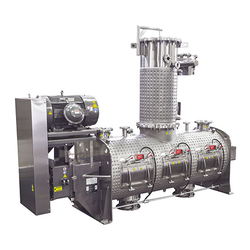How To Size a Plow Mixer

How to determine the most efficient size for a plow mixer is a common question for the mixing equipment sales staff. There are many variables to consider when sizing a machine and the entire system needs to be considered with every change to the manufacturing process. The typical order of importance for sizing a plow mixer used by B&P Littleford starts with process description – is it a batch process or a continuous process? This will determine if the processor uses a plow mixer from the KM line (continuous) or FKM/DVT line (batch).
Using a Versatile Batch Process Plow Mixer
For this sizing exercise, it’s assumed the operation will utilize a batch process plow mixer. There are many different processes that can be carried out in this equipment such as mixing, drying, reacting, coating, agglomerating, and more. In many cases, plow mixers are selected because more than one process can be carried out in the same machine without transferring the material to another piece of equipment.
Drum Volume
Plow mixers from B&P Littleford are sized based on drum volume in liters. An FKM-10000 has a total capacity of 10,000 liters. This, however, does not mean it will process a 10,000 liter batch. There needs to be enough head space for the material within the plow mixer to fluidize. The rule for volumetric sizing is that the batch should fill 30-70% of the free volume of the vessel. This will ensure there is enough material for the plow elements to contact and move, yet enough free space for it to also properly fluidize.
Motor Horsepower
The next major plow mixer sizing hurdle comes in the selection of the motor horsepower requirements. Some operations are a relatively simple blend of dry powders and don’t need a lot of power. Others, especially drying applications that go through a paste-like consistency, require a lot more power to push through that highly viscous stage. While the vast majority of machines built are sized based on running machine trials at the Saginaw, MI Tech Center, there is a quick reference to follow: 15hp/1,000lb of free-flowing product (light powder) at full speed. The power requirements would go up from there if the material is tacky or cohesive.
There are many other details and options available to go into a plow mixer build, but the general ideas presented here should get someone started down the right path. If there are any questions on new or existing machines, the people of B&P Littleford are always willing to help. You can find machine sizes in the TDS brochure for each mixer type at www.bplittleford.com.
